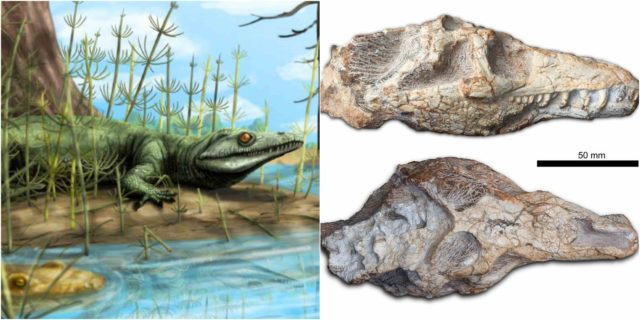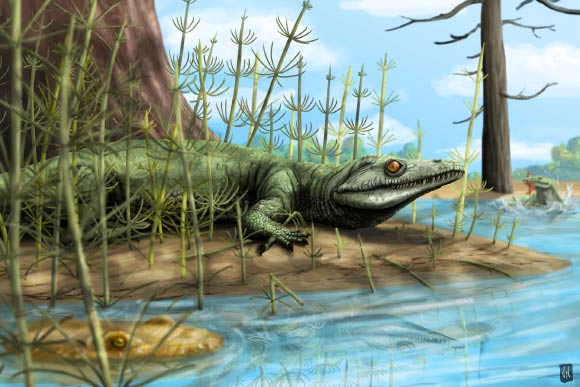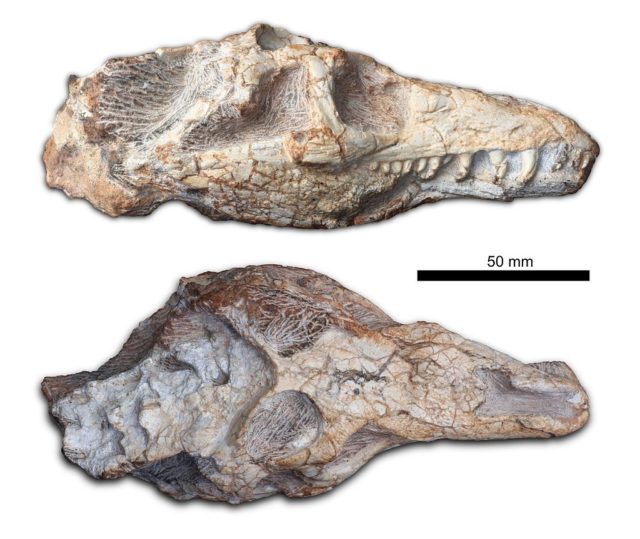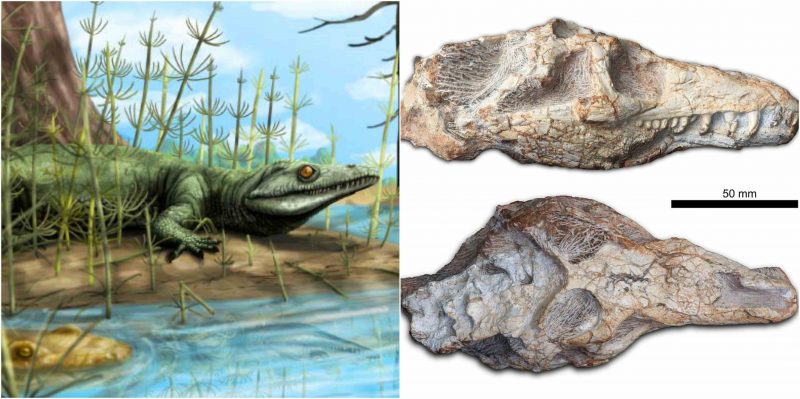
There is an old legend from Brazil that tells of a cursed father and his sons. The first son, Teyú Yaguá, ended up as a large lizard with a dog’s head. He was one of the seven monsters that terrified ancient Brazil.
Now, researchers have found fossils of a new species that curiously resembles this giant dog-lizard. This lizard, found in exposed Triassic rock near the city of São Francisco de Assis in southern Brazil, has been dated to about 250 million years ago. The team that made the discovery consists of scientists from Brazil to the UK. The animal has been named Teyujagua paradoxa, in honour of the legendary monster.

Unlike its namesake, Teyujagua was a small, quadrupedal animal that grew to be about 1.5 meters in length. Although it didn’t have the head of a dog, its teeth were recurved, with fine serrations and sharply-pointed, meaning it probably ate meat. Its nostrils were placed on the upper part of the snout, much like modern-day crocodiles. Teyujagua lived in lakes and rivers, hunting amphibians and small-bodied reptiles similar to lizards. Its discovery is now helping scientists to understand how modern-day birds and crocodiles first evolved.
According to Dr. Richard Butler from the University of Birmingham, “Teyujagua is a really important discovery because it helps us understand the origins of a group of vertebrates called archosauriforms”.

Teyujagua is very different from other fossils found at the same time; the anatomy appears to be in a stage between the more primitive reptiles and the group of archosauriforms. The archosauriform group is incredibly diverse, Dr. Butler clarified, and it includes everything from hummingbirds and crocodiles to giant dinosaurs like Tyrannosaurus Rex and Brachiosaurus. In studying the Teyujagua, researchers can piece together how the skulls of early animals first formed.
The Teyujagua paradoxa lived at a time when 90% of the living species on earth had been wiped out in the Permo-Triassic mass extinction, approximately 252 million years ago. It was thought to have been triggered by a giant and intense volcanic eruption in what is now eastern Russia.
The Permo-Triassic mass extinction was by no means the only one. In earth’s history, there have been five events, all called mass extinctions, in which a majority of the world’s life has been wiped out. The first is called the End-Ordovician mass extinction. Occurring around 540 million years ago, it was probably the second most severe. At that time, virtually all life was in the sea at the time and around 85% of these species vanished. The second event, 375-359 million years ago, is called the Late Devonian mass extinction. This event was a drawn-out affair – major environmental changes wiped out most fish groups and prevented new coral reefs from forming for 100 million years. The End-Permian (Permo-Triassic) mass extinction is also called the Great Dying, and for good reason. It is the largest extinction event and affected the earth’s ecology the most profoundly, with as much as 97% of species that leave a fossil record disappearing forever.
Dinosaurs first appeared in the Early Triassic period. Large amphibians and mammal-like reptiles were the dominant land animals. The End-Triassic mass extinction changed that around 201 million years ago. The last mass extinction came in the form of an asteroid that impacted earth about 66 million years ago. The mass extinction level event, which caused the End-Cretaceous mass extinction, is blamed for ending the reign of dinosaurs.

In the aftermath of the extinction, the ecosystems on land were very sparsely populated. This meant that some groups of survivors expanded in number and diversified. Very likely, archosauriforms and their close kin, including Teyujagua, became the dominant animals, eventually giving rise to dinosaurs.
“Teyujagua fills an evolutionary gap between archosauriforms and more primitive reptiles and helps us understand how the archosauriform skull first evolved. The discovery of Teyujagua was really exciting,” said Dr. Felipe Pinheiro, another researcher on the project, from Universidade Federal do Pampa. His enthusiasm was evident as he continued, “Ever since we saw that beautiful skull for the first time in the field, still mostly covered by rock, we knew we had something extraordinary in our hands. Back in the lab, after slowly exposing the bones, the fossil exceeded our expectations. It had a combination of features never seen before, indicating the unique position of Teyujagua in the evolutionary tree of an important group of vertebrates.”

The discovery was originally published in the journal Scientific Reports. It helped to clarify the beginnings of the group that gave rise to dinosaurs, pterosaurs, crocodiles, and birds. Not only that, but researchers hope to gain new insights into how ecosystems worked just before the appearance of the first dinosaurs and the environment just after the mass extinction 252 million years ago.
Excavations in the site where Teyujagua was found are ongoing.
